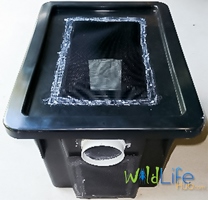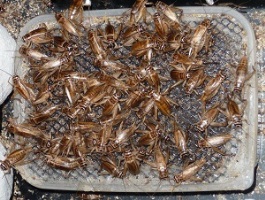It’s Essential You Choose the Right Cricket Breeding Method !!
Avoid Being One of the 98% of People Who Fail to Breed Crickets After a Few Months
There are a number of methods to breed crickets which can be confusing to the beginner. Given that around 98% of People stop breeding crickets after a few months, choosing the right method is the single most important step to determine if you succeed or fail over the long term.
The most common mistake people make, is choosing a commercial method (with higher maintenance), for private production. Below is a brief summary of the advantages and disadvantages of each method, however we discuss this in much greater detail in our Cricket Breeding Training Course.
Zega Substrate Cricket Breeding System (Private and Small Scale Commercial)
This unique method has two separate zones within a single container; one high humidity area ideal for breeding; and a lower humidity area which is required for housing and food/water. It also has a unique detritus collection system which collects the waste and prevents contamination of breeding substrate and food areas.
- T
 his makes cleaning very quick, eliminates odors and disease, increases egg viability and significantly increases cricket production. It has automated water and food dispensers which do the feeds for you, even when you’re on holidays! Unlike conventional techniques which need to be actively managed (daily spraying, and moving pinheads to new containers), this systems runs itself.
his makes cleaning very quick, eliminates odors and disease, increases egg viability and significantly increases cricket production. It has automated water and food dispensers which do the feeds for you, even when you’re on holidays! Unlike conventional techniques which need to be actively managed (daily spraying, and moving pinheads to new containers), this systems runs itself. - As a result, this low maintenance and productive method is well suited to private and small scale commercial production.
- This method only requires a single container, unlike other methods which require 7 separate containers to prevent cannibalism.
- We recommend using this method for someone who wants to feed 4-12 bearded dragons or around 1000 large crickets/month. For larger quantities we recommend using the breeding tray method described below.
Breeding Tray Method (Medium and Large Scale Production)
This method involves the spraying of breeding trays, and moving baby pinheads into 7 separate containers to prevent cannibalism.
 Due to the higher maintenance and active management required to manage multiple containers at the same time, this method is not well suited to private or small scale commercial production. It is however better suited to medium and large scale breeding, where the higher production justifies the extra management (greater than 1000 large crickets/month).
Due to the higher maintenance and active management required to manage multiple containers at the same time, this method is not well suited to private or small scale commercial production. It is however better suited to medium and large scale breeding, where the higher production justifies the extra management (greater than 1000 large crickets/month).
Despite its limitations in private production, it is commonly used and is the main reason why 98% of people give up breeding crickets after just a few months.
As you can see, giving some thought to the right breeding method for your needs can save you a lot of effort and time in the long run.

 his makes cleaning very quick, eliminates odors and disease, increases egg viability and significantly increases cricket production. It has automated water and food dispensers which do the feeds for you, even when you’re on holidays! Unlike conventional techniques which need to be actively managed (daily spraying, and moving pinheads to new containers), this systems runs itself.
his makes cleaning very quick, eliminates odors and disease, increases egg viability and significantly increases cricket production. It has automated water and food dispensers which do the feeds for you, even when you’re on holidays! Unlike conventional techniques which need to be actively managed (daily spraying, and moving pinheads to new containers), this systems runs itself.